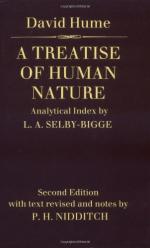Nor must we omit on this occasion our accustomed method of examining ideas by considering those impressions, from which they are derived. The impressions, which enter by the sight and hearing, the smell and taste, are affirmed by modern philosophy to be without any resembling objects; and consequently the idea of solidity, which is supposed to be real, can never be derived from any of these senses. There remains, therefore, the feeling as the only sense, that can convey the impression, which is original to the idea of solidity; and indeed we naturally imagine, that we feel the solidity of bodies, and need but touch any object in order to perceive this quality. But this method of thinking is more popular than philosophical; as will appear from the following reflections.
First, It is easy to observe, that though bodies are felt by means of their solidity, yet the feeling is a quite different thing from the solidity; and that they have not the least resemblance to each other. A man, who has the palsey in one hand, has as perfect an idea of impenetrability, when he observes that hand to be supported by the table, as when he feels the same table with the other hand. An object, that presses upon any of our members, meets with resistance; and that resistance, by the motion it gives to the nerves and animal spirits, conveys a certain sensation to the mind; but it does not follow, that the sensation, motion, and resistance are any ways resembling.
Secondly, The impressions of touch are simple impressions, except when considered with regard to their extension; which makes nothing to the present purpose: And from this simplicity I infer, that they neither represent solidity, nor any real object. For let us put two cases, viz. that of a man, who presses a stone, or any solid body, with his hand, and that of two stones, which press each other; it will readily be allowed, that these two cases are not in every respect alike, but that in the former there is conjoined with the solidity, a feeling or sensation, of which there is no appearance in the latter. In order, therefore, to make these two cases alike, it is necessary to remove some part of the impression, which the man feels by his hand, or organ of sensation; and that being impossible in a simple impression, obliges us to remove the whole, and proves that this whole impression has no archetype or model in external objects. To which we may add, that solidity necessarily supposes two bodies, along with contiguity and impulse; which being a compound object, can never be represented by a simple impression. Not to mention, that though solidity continues always invariably the same, the impressions of touch change every moment upon us; which is a clear proof that the latter are not representations of the former.
Thus there is a direct and total opposition betwixt our reason and our senses; or more properly speaking, betwixt those conclusions we form from cause and effect, and those that persuade us of the continued and independent existence of body. When we reason from cause and effect, we conclude, that neither colour, sound, taste, nor smell have a continued and independent existence. When we exclude these sensible qualities there remains nothing in the universe, which has such an existence.




